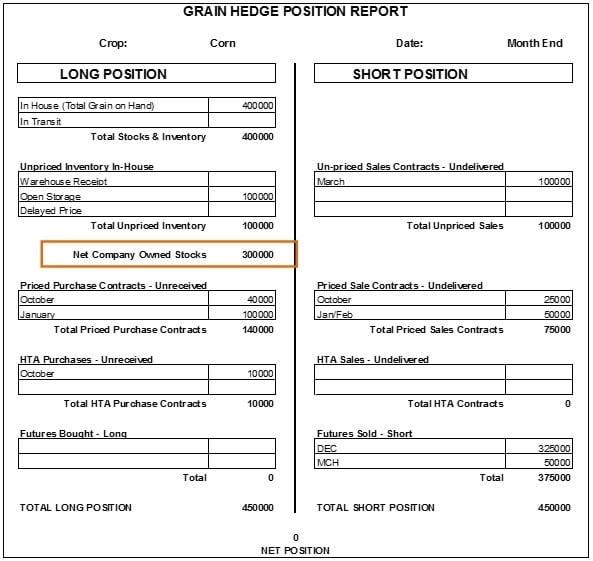 This week's blog will answer some frequently asked questions regarding some alternative grain company financing tools. For a general overview of these tools, please refer to our previous blog posts on Grain Repos and Grain Swaps.
This week's blog will answer some frequently asked questions regarding some alternative grain company financing tools. For a general overview of these tools, please refer to our previous blog posts on Grain Repos and Grain Swaps.
Grain Repos:
- During the course of the repo agreement with the bank, are the margin calls funded from the line of credit that the elevator has with the bank? Not typically, but it could be done either way and that is why the interest cost is separated out in the discussions. The key is that the total cost of the product has an effective yield which will equate to the interest cost. One common model does take a fee on the entire position and the grain company is not responsible for the interest cost.
- Since the elevator has an obligation to repurchase the inventory, does the elevator show that as a liability on their balance sheet with a corresponding mark-to-market valuation of the grain as an asset? Technically the inventory position has been sold and warehouse receipts are delivered to the bank with a purchase contract to buy the bushels back at a later date. Both positions should be marked to market, for both entities. These bushels may need to be carried by the grain company after the Repo is completed and the bank and grain company need to be ready for those financing needs.
- Effective interest rate of a repo compared to committed credit facility – are they competitive? They didn’t use to be, but the costs are getting closer now. There is still a risk premium built in, but competition, abundance of capital, and lack of use has brought the rates and fees down. The fee will usually cover $2 to $4 moves in the market.
- What are the hidden costs? All costs should be clearly spelled out in the contract.
- How is this product beneficial to our customers? Strictly from a cost versus benefit analysis it is beneficial to the owners of grain in rising markets. If the market is flat or dropping, they will pay for insurance that is unused. When used properly, these products can take the peak off the lines and lower all of the affiliated costs.
- Do repos increase borrowing capacity? It may defer financing requirements through a peak period, which may be beneficial. However, at the end of the contract, the inventory will need to come back on the balance sheet. If accounted for and marked to market properly, repos don’t actually create working capital or equity so they shouldn’t be used to further leverage additional borrowings.
- How important is counterparty risk for repurchase agreements? Counterparty risk is always a major consideration. However, the grain company has possession of the money and the grain remains in the bin.
Grain Swaps:
- How is this product typically used? Repos and Swaps are insurance against a market rally. Only a prudent number of bushels should be included, and typically only a portion of the total bushels are hedged in this fashion. Remember the market moves both ways and you are paying a fee to not pay margin calls. Swaps can also be used as a lender of last resort or protection against a bank not being able or willing to make margin calls.
- During the course of the swap agreement with the bank, are margin calls funded by the counterparty? If the counterparty (Bank) actually enters the swap market they do not fund the position or receive margin surplus until the deal is completed. A fee is charged in essence to buy time away from the volatility. It is possible to charge the fee and not enter the market – just carry the position. In this case the bank would assume the market risk and fund the position. There have been numerous examples of banks and other financial institutions wiping out billions of dollars in equity by taking positions and assuming market risk.
- Does the elevator give up flexibility with either of these products (for carry and/or basis gain)? Only to the extent that the elevator may exit the swap or repo early and prepay a fee for a period of time they don’t actually use. A basis trader will still sell good basis even if a repo has been executed, then the repo will be terminated and the position will be brought back to the elevator prior to delivery to the end user. The early termination possibility should be written into the contract.
- What are the hidden costs? All costs should be spelled out in the contract.
- How is pricing impacted by tenor and market volatility? The commodity swaps for inventory or forward contracts are typically priced on volatility and time. Longer time periods and more volatility will bring higher prices. This is all based on the banks Over-The-Counter pricing desk.
- While owned by a major bank or trading house the financial capacity of the actual SWAP counterparty may be limited, but what happens if the counterparty defaults? The elevator and primary bank will take the position back earlier than anticipated and possibly at a loss.
- Any insights into the market position of the SWAP seller? Are the sellers open and making a bet on the flat price movement or hedging the opposition with option strategy and extracting a profit from the option premiums? Just like any market there are hedgers and speculators with the primary lender acting as a reinsurer.
- Do grain companies have counterparty risk with Over-The-Counter Swaps? Swaps do expose grain companies to counterparty risk. If the market retreats on a short position or rallies on a long position, a receivable is created. Unlike Repos where the grain company has the inventory in the bin and money from the repo provider, swaps typically require no collateral. If the counterparty cannot give back your short position in the event of a market retreat, or the long position in a market rally, a receivable will need to be collected.
Credit Issues:
- Are letters of credit or other enhancements required to assure performance of the elevator on SWAP transactions? Most banks that offer swaps have a piece of the operating credit line. Therefore, they have probably done the credit analysis before the swap is offered.
- Will borrowing bases need to be modified to assure any grain pledged under REPO or SWAP agreements is excluded from the BBR? Yes, the positions will need to be marked to the market and integrated into the current borrowing base to ensure that the borrower has the liquidity and credit availability to take the position back in the case of counterparty default.
- Will reserves need to be included in the BBR depending on the credit structure/profile? Yes, what happens if the counterparty defaults and the position comes back to the grain company early? Think back to 2008 and remember what happens if anyone goes past their balance sheet. A twenty year coop manager or multi-generational independent owner knows that the futures position has to come back on the balance sheet and will need to be financially prepared.
To cover this and many other related topics in greater depth, please click below for information on our upcoming "Strategic Planning for Grain Companies" course.


 This week's blog will answer some frequently asked questions regarding some alternative grain company financing tools. For a general overview of these tools, please refer to our previous blog posts on Grain Repos and Grain Swaps.
This week's blog will answer some frequently asked questions regarding some alternative grain company financing tools. For a general overview of these tools, please refer to our previous blog posts on Grain Repos and Grain Swaps.

